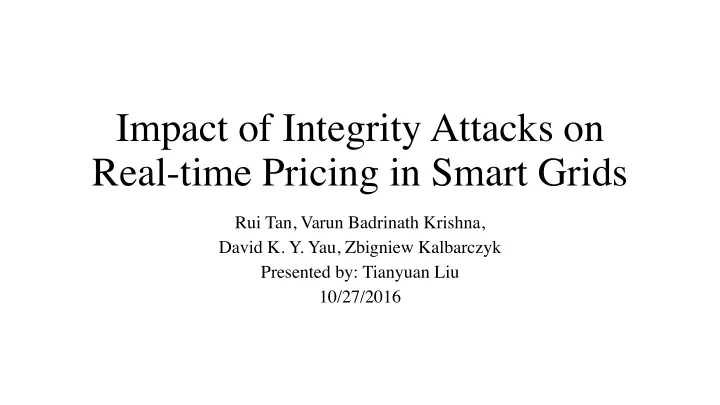

Impact of Integrity Attacks on Real-time Pricing in Smart Grids Rui Tan, Varun Badrinath Krishna, David K. Y. Yau, Zbigniew Kalbarczyk Presented by: Tianyuan Liu 10/27/2016
Background Real-time Pricing (RTP) in Smart Grid • Balance the demand and supply • (Smart) consumers behave differently under different prices Day-ahead predicted price Real-time price 2
� � Quick Model & Solution • Supply 𝑡 𝜇 = ∑ 𝑡 % (𝜇) % • Demand d 𝜇 = ∑ 𝑓 % (𝜇) + 𝑐𝑏𝑡𝑓𝑚𝑗𝑜𝑓 % % 3
Quick Model & Solution • Minimize the scheduling error min 3 4 𝑡 𝜇 5 − 𝑒 𝜇 5 𝜇 5 = 𝑡 9: (𝑒 𝜇 59: ) 𝑡 𝜇 5 ← 𝑒 𝜇 59: 4
Unstable RTP 5
Unstable RTP 6
Unstable RTP 𝑡 𝜇 5 ← 𝑒 𝜇 59: 7
Unstable RTP 8
Unstable RTP 9
Unstable RTP 10
Unstable RTP Summary Diverging price may lead to • Overloaded power network • Wasted power • Increased operational cost System vulnerable to integrity attacks • False data injection • Take down the whole Smart Grid system 11
Stabilizing RTP Control-theoretic approach • Stabilizing the scheduling error • Scheduling error ~ supply – elastic demand 12
Stabilizing RTP 2𝜃 𝜇 5 = 𝜇 59: + (𝑡 59: − 𝑓 59: ) 𝑔 𝜇 > 13
Integrity Attack Models Scaling attack • Inject false price value • 𝜇 5 → 𝛿𝜇 5 • 0 < 𝛿 < 1 , decreased price -> increased demand • 𝛿 > 1 , increased price -> decreased demand Delay attack • Use old price information • 𝜇 5 → 𝜇 59E 14
Analytic Results – Scaling Attack Region of stability • 𝛿 : scaling factor • 𝜍 : ratio of compromised smart meters • ℎ ≜ İ(3 K ) L̇(3 K ) : marginal demand-supply ratio at fixed operating point 15
Analytic Results – Delay Attack • 𝜐 : delay (hours) • 𝜍 : ratio of compromised smart meters • ℎ ≜ İ(3 K ) L̇(3 K ) : marginal demand-supply ratio at fixed operating point 16
Simulation GridLAB-D • Physical characteristics • 1405 consumers • Simulating consumers with/without attacks Results • The system is stable without attack or with weak attack • The system can be destabilized only if attackers are super strong (large 𝜍, 𝜐 and small 𝛿 ) 17
Discussion Contributions • Comprehensive theoretical analysis • Good resilience under attacks Limitations • Simple Model? Less important security issue? Results too good? Or not a problem to worry about? How do you like the idea of applying control-theoretic approach here? 18
Recommend
More recommend